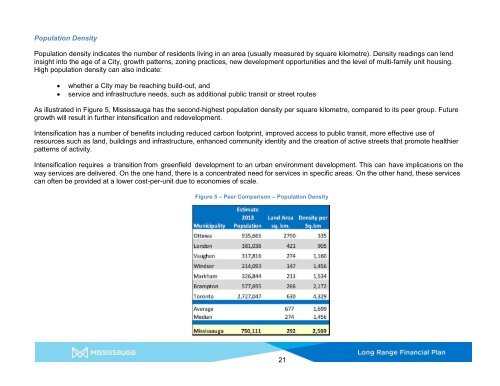Long Range Financial Plan
Create successful ePaper yourself
Turn your PDF publications into a flip-book with our unique Google optimized e-Paper software.
Population Density<br />
Population density indicates the number of residents living in an area (usually measured by square kilometre). Density readings can lend<br />
insight into the age of a City, growth patterns, zoning practices, new development opportunities and the level of multi-family unit housing.<br />
High population density can also indicate:<br />
<br />
<br />
whether a City may be reaching build-out, and<br />
service and infrastructure needs, such as additional public transit or street routes<br />
As illustrated in Figure 5, Mississauga has the second-highest population density per square kilometre, compared to its peer group. Future<br />
growth will result in further intensification and redevelopment.<br />
Intensification has a number of benefits including reduced carbon footprint, improved access to public transit, more effective use of<br />
resources such as land, buildings and infrastructure, enhanced community identity and the creation of active streets that promote healthier<br />
patterns of activity.<br />
Intensification requires a transition from greenfield development to an urban environment development. This can have implications on the<br />
way services are delivered. On the one hand, there is a concentrated need for services in specific areas. On the other hand, these services<br />
can often be provided at a lower cost-per-unit due to economies of scale.<br />
Figure 5 – Peer Comparison – Population Density<br />
21







